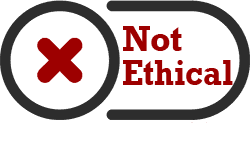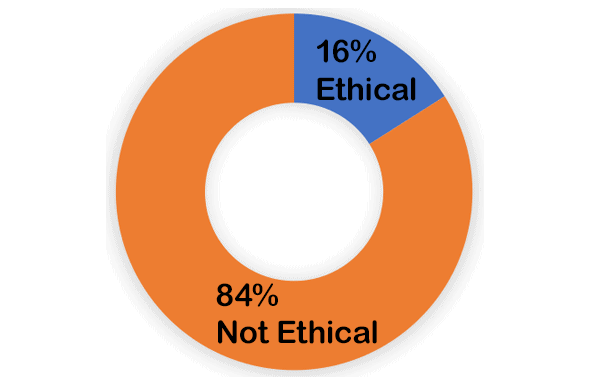This is the February 2021 edition of our monthly series of Ethics case studies titled What Do You Think? This series is comprised of case studies from NSPE archives, involving both real and hypothetical matters submitted by engineers, public officials and members of the public.
Your peers and the NSPE Board of Ethical Review have reviewed the facts of the case as shown below. And, here are the results.
Your opinion has been registered for the February 2021 edition of our monthly series of Ethics case studies titled What Do You Think?
Your vote is recorded as:

Want to know how your peers voted? We’ll send you an email with the poll results on February 23.
Your opinion has been registered for the February 2021 edition of our monthly series of Ethics case studies titled What Do You Think?
Your vote is recorded as:

Want to know how your peers voted? We’ll send you an email with the poll results on February 23.
A Review of the Facts
Ralph is a field technician employed by a consulting environmental engineering firm. At the direction of Engineer Patrick, his supervisor, Ralph, samples the contents of drums located on the property of a client. Based on Ralph’s past experience, it is his opinion that the analysis of the sample would most likely determine that the drum contents would be classified as hazardous waste. If the material is hazardous waste, Ralph knows that certain steps would legally have to be taken to transport and properly dispose of the drum, including notifying the proper federal and state authorities.
Ralph asks his supervisor, Patrick, what to do with the samples. Patrick tells Ralph only to document the existence of the samples. Ralph is then told by Patrick that since the client does other business with the firm, Patrick will tell the client where the drums are located but do nothing else. Thereafter, Patrick informs the client of the presence of drums containing “questionable material” and suggests that they be removed. The client contacts another firm and has the material removed.
Was it ethical for Patrick to merely inform the client of the presence of the drums and suggest that they be removed, but not inform his client that he suspected hazardous material?
Here is the result of our survey of your peers:

Applicable NSPE Code References:
Code II.1: Engineers shall hold paramount the safety, health, and welfare of the public.Code II.1.a: If engineers’ judgment is overruled under circumstances that endanger life or property, they shall notify their employer or client and such other authority as may be appropriate.
Code II.1.c: Engineers shall not reveal facts, data, or information without the prior consent of the client or employer except as authorized or required by law or this Code.
Code II.3.a: Engineers shall be objective and truthful in professional reports, statements, or testimony. They shall include all relevant and pertinent information in such reports, statements, or testimony, which should bear the date indicating when it was current.
Code III.1: Engineers shall be guided in all their professional relations by the highest standards of integrity.
Code III.3: Engineers shall avoid all conduct or practice that deceives the public.
Code III.3.a: Engineers shall avoid the use of statements containing a material misrepresentation of fact or omitting a material fact.
Code III.4: Engineers shall not disclose, without consent, confidential information concerning the business affairs or technical processes of any present or former client or employer, or public body on which they serve.
Discussion
The extent to which an engineer has an obligation to hold paramount the public health and welfare in the performance of professional duties (Code I.1) has been widely discussed by the Board of Ethical Review over the years. In many of these cases, this basic duty has frequently intersected with the duty of engineers not to disclose confidential information concerning the business affairs, etc., of clients (Code III.4)
For example, in BER Case 89-7, an engineer was retained to investigate the structural integrity of a 60-year-old occupied apartment building that his client was planning to sell. Under the terms of the agreement with the client, the structural report written by the engineer was to remain confidential. In addition, the client made it clear to the engineer that the building was being sold “as is,” and the client was not planning to take any remedial action to repair or renovate any system within the building.
The engineer performed several structural tests on the building and determined that the building was structurally sound. However, during the course of providing services, the client confided in the engineer that the building contained deficiencies in the electrical and mechanical systems, which violated applicable codes and standards. While the engineer was not an electrical nor mechanical engineer, he did realize that those deficiencies could cause injury to the occupants of the building and so informed the client. In his report, the engineer made a brief mention of his conversation with the client concerning the deficiencies; however, in view of the terms of the agreement, the engineer did not report the safety violations to any third parties.
In determining that it was unethical for the engineer not to report the safety violations to appropriate public authorities, the Board, citing cases decided earlier, noted that the engineer “did not force the issue but instead went along without dissent or comment. If the engineer’s ethical concerns were real, the engineer should have insisted that the client take appropriate action or refuse to continue work on the project.” The Board concluded that the engineer had an obligation to go further, particularly because the Code uses the term “paramount” to describe the engineer’s obligation to protect the public safety health and welfare.
In BER Case 90-5, the Board reaffirmed the basic principle articulated in BER Case 89-7. There, tenants of an apartment building sued its owner to force him to repair many of the building’s defects. The owner’s attorney hired an engineer to inspect the building and give expert testimony in support of the owner. The engineer discovered serious structural defects in the building, which he believed constituted an immediate threat to the safety of the tenants. The tenants’ suit had not mentioned these safety-related defects. Upon reporting the findings to the attorney, the engineer was told he must maintain this information as confidential as it is part of the lawsuit. The engineer complied with the request.
In deciding it was unethical for the engineer to conceal his knowledge of the safety-related defect, the Board discounted the attorney’s statement that the engineer was legally bound to maintain confidentiality, noting that any such duty was superseded by the immediate and imminent danger to the building’s tenants. While the Board recognized that there might be circumstances where the natural tension between the engineer’s public welfare responsibility and the duty of non-disclosure may be resolved in a different manner, the Board concluded that this clearly was not the case under the facts.
Turning to the facts, in this case, we believe the basic principles enunciated in BER Cases 89-7 and 90-5 are applicable here as well, except in a different context. Unlike the facts in the earlier cases, Patrick made no oral or written promise to maintain the client’s confidentiality. Instead, Patrick consciously and affirmatively took actions that could cause serious environmental danger to workers and the public, and also a violation of various environmental laws and regulations.
Under the facts, it appears that Patrick’s primary concern was not so much maintaining the client’s confidentiality as it was in maintaining good business relations with a client. In addition, it appears that as in all cases which involve potential violations of the law, Patrick’s actions may have had the effect of seriously damaging the long-term interests and reputation of the client. In this regard, we would also note that under the facts, it appears that the manner in which Patrick communicated the presence of the drums on the property must have suggested to the client that there was a high likelihood that the drums contained hazardous materials. We believe that this subterfuge is wholly inconsistent with the spirit and intent of the Code of Ethics because it makes the engineer an accomplice to what may amount to unlawful action.
Clearly, Patrick’s responsibility was to bring the matter of the drums possibly containing hazardous material to the attention of the client with a recommendation that the material be analyzed. To do less would be unethical. If analysis demonstrates that the material is indeed hazardous, the client would have the obligation of disposing of the material in accordance with applicable federal, state, and local laws.
The Ethical Review Board’s Conclusion

It was unethical for Patrick to merely inform the client of the presence of the drums, but fail to advise his client that he suspected hazardous material and provide a recommendation concerning removal and disposal in accordance with federal, state, and local laws.
BOARD OF ETHICAL REVIEW
William A. Cox, Jr., P.E. William W. Middleton, P.E. William E. Norris, P.E. William F. Rauch, Jr., P.E., Jimmy H. Smith, P.E., Otto A. Tennant, P.E., Robert L. Nichols, P.E., Chairman
Note – In regard to the question of application of the Code to corporations vis-a-vis real persons, business form or type should not negate nor influence conformance of individuals to the Code. The Code deals with professional services, which services must be performed by real persons. Real persons in turn establish and implement policies within business structures. The Code is clearly written to apply to the Engineer and it is incumbent on a member of NSPE to endeavor to live up to its provisions. This applies to all pertinent sections of the Code. This opinion is based on data submitted to the Board of Ethical Review and does not necessarily represent all of the pertinent facts when applied to a specific case. This opinion is for educational purposes only and should not be construed as expressing any opinion on the ethics of specific individuals. This opinion may be reprinted without further permission, provided that this statement is included before or after the text of the case.








If a lawyer discovered this it would be considered confidential and against his clients’s interests to report.
Waste characterization is the responsibility of the generator. Patrick’s suspicions regarding the likely outcome of the tests are not relevant. Patrick did not advise the client to dispose of the waste as non-hazardous, merely to dispose of the waste. Midnight dumping is no longer a thing. No waste disposal facility or waste transporter would manage the waste as non-hazardous without tests showing as such. If Patrick later found out that the drums were disposed of, or planned to be disposed of, without such tests, then he would have a duty to respond. Otherwise, he is on firm ground to leave the testing requirements to the disposal facility’s waste profiling process in accordance with their permit.
When I read the commentary the opinion seems to be parsing words to get the conclusion they desire. From my experience of providing results to clients, using the statement
Thereafter, Patrick informs the client of the presence of drums containing “questionable material”
Would also include the facts that the materials were not tested and samples were available to be tested, since “Questionable” in my mind would include “Hazardous” as a possibility.
One of the curious items in the description is why the engineer would not test the materials they found. If there was a suspicion that the materials were hazardous the prudent move would have been to test the material.
If there is an ethical violation, it is in the failure to determine if the materials were hazardous not in the reporting to the client of the potential problem. If, as the board determined, the action is unethical the issue was in not determining if the material is hazardous, even if that cost was to his expense, so that his duty to the client was fulfilled.
I would like to note that, in my opinion, the upfront facts as presented, were not completely clear. Thus, in making my vote for not ethical, I had to make some assumptions that, ultimately, were confirmed in the subsequent discussion. For example, was testing within the scope of the firm? It is only implied. If it was included, the ethical violation is clear. If not, the case could be made that the back-handed reference to “questionable material” was an attempt to drum up that scope. However it appears that no testing was ever done, even by the entity that removed the material. Assuming all of this is the case, there is still an ethical violation due to the subsequent silence by the firm as to the potential hazard.
The discussion and comments do not address if the samples themselves were moved as part of the testing. This were most likely illegally transported off the site for analysis.
Why take samples if they were not to be tested? Seems pointless. The entire point of taking a sample is to discover what the content of the container is. At the least, the engineer should have told the client that there were samples taken and state that they need to be tested. Anything less would be a failure to perform your professional duty. Specifically, Patrick’s action are unacceptable. At the least he should be looking for work in some other field that does not expect professional or personal integrity.
Who placed the material in the drums and who placed the drums in their location on the property? If the engineers had addressed these facts then it would allowed for a precise determination of the status as hazardous or non-hazardous. The assignment appears to have not been addressed professionally and the connotations suggest negligence and side-stepping of responsibility and is therefore unethical.
The sin of omission to maintain plausible deniability may be an effective legal defense, but this is an ethics case not a matter of determining if one is acting within the letter of the law. The actions of Patrick and the client appear to be supporting a desire to stay ‘ignorant’ of the facts without regard to potential environmental or human harm if insufficient controls are used in the handling, transportation, and disposal of the material. Knowingly staying ignorant to avoid potential costly controls is not holding public safety as paramount. In these situations if the worst happens, the client gets off since they have plausible deniability and are not bound to an ethical code. While the engineer gets hung out to dry because their code of ethics indicates they should have known or found out before allowing a potentially reckless act to occur on their watch. (storing/transporting/disposing of potentially hazardous substance).
Excellent analysis, Mitch. I agree with your thoughts – you looked at it from both sides of the fence, the legal and the technical/ethical.
One aspect of this discussion that has not been discussed is “Political Correctness”. We have become a country of Differential Truths. So, a few definitions might be in order. First of all FACT is derived from the Latin Word FACTA which means ACTIONS. Ergo facts are based on actions. TRUTH on the other hand is very undefinable. Prof Goedel’s Incompleteness Theorem is also a proof that TRUTH does not drive your beliefs, rather your beliefs define Truth. Pontius Pilate stated this at the Trial of one Nazarene Carpenter when he asked the rhetorical question, ‘What is Truth?’
Just as a side note, both Space Shuttle crashes were the results of ignoring a ‘questionable’ condition and concluding optimistic results based on politically correct truths.